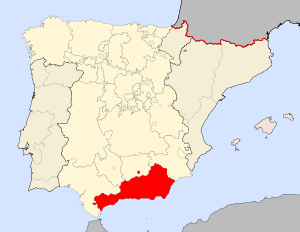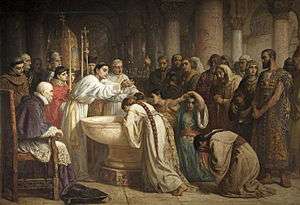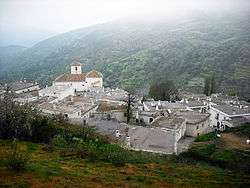Rebellion of the Alpujarras (1499–1501)
| Rebellion of the Alpujarras (1499–1501) | |||||||
|---|---|---|---|---|---|---|---|
 The Kingdom of Granada in Castile. | |||||||
| |||||||
| Belligerents | |||||||
|
|
| ||||||
| Commanders and leaders | |||||||
|
| unknown | ||||||
| Strength | |||||||
| 80,000[1] | unknown | ||||||
The Rebellion of the Alpujarras (1499–1501) were a series of uprisings by the Muslim population of the Kingdom of Granada, Crown of Castile (formerly, the Emirate of Granada) against their Catholic rulers. They began in 1499 in the city of Granada in response to mass forced conversion of the Muslim population to the Catholic faith, which were perceived as violations of the 1491 Treaty of Granada.[2][3][4] The uprising in the city quickly died down, but it was followed by more serious revolts in the nearby mountainous area of the Alpujarra. The Catholic forces, on some occasions led personally by King Ferdinand, succeeded in suppressing the revolts and exacted severe punishment on the Muslim population.
The Catholic rulers used these revolts as a justification to abolish the Treaty of Granada and the rights of the Muslims guaranteed by the treaty.
Background

The Emirate of Granada was the last Muslim-ruled area in the Iberian peninsula. In January 1492, after a decade-long campaign, Muhammad XII of Granada (also known as "Boabdil") surrendered the Emirate to the Catholic forces led by the Catholic monarchs Ferdinand II of Aragon and Isabella I of Castile. The Treaty of Granada, signed on November 1491, guaranteed a set of rights to the Muslims of Granada, including religious tolerance and fair treatment, in return for the capitulation.
At this point, the Muslim population in the former Emirate of Granada was estimated to be between 250,000 and 300,000, making up the majority in the former emirate, and constituting roughly half of the entire Muslim population in Spain.[5]
Initially, the Catholic rulers upheld the treaty. Despite pressure from the Spanish clergy, Ferdinand and the Archbishop of Granada Hernando de Talavera chose a laissez-faire policy towards the Muslims in the hope that interaction with Catholics would make them "understand the error" of their faith and abandon it. When Ferdinand and Isabella visited the city in the summer of 1499, they were greeted by enthusiastic crowd, including Muslims.[6]
In the summer of 1499, Francisco Jiménez de Cisneros, the archbishop of Toledo, arrived in Granada and began working alongside Talavera. Cisneros disliked Talavera's approach and began sending uncooperative Muslims, especially the noblemen, to prison, where they were treated harshly until they agreed to convert. Emboldened by the increase in conversions, Cisneros intensified the efforts and in December 1499 he told Pope Alexander VI that three thousand Muslims converted in a single day. Cisneros' own church council warned that these methods might be a breach of the Treaty, and sixteenth-century hagiographer Álvar Gómez de Castro described the approach as "methods that were not correct".[7]
Uprising in Albayzin
.jpg)
The increasing mass and forced conversion of Muslims triggered resistance, initially among the urban population of Albayzin (also spelled Albaicín), the Muslim quarter of Granada.[8] The situation was exacerbated by the treatment of elches, former Christians who converted to Islam. Specific clauses in the Treaty of Granada forbade the conversion of the elches back to Christianity against their will, but the treaty allowed for questionings of such converts by Christian clerics, in the presence of Muslim religious authorities. Cisneros used this 'loophole' to summon elches and imprison those who refused to return to Christianity. These efforts were often focused on wives of Muslim men – an emphasis that angered the Muslim population who considered this a violation of their families.[8]
On 18 December 1499, as part of this effort, constable Velasco de Barrionuevo and an assistant were taking a female elche from Albayzin for such questioning. When they passed through a square, she shouted that she was being forced to become Christian. The officials were then surrounded by a hostile crowd, and the constable was killed and the assistant managed to escape after being sheltered by a local Muslim woman.[4]
This incident escalated into an open revolt. The residents of Albayzin barricaded the streets and armed themselves. An angry crowd marched to Cisneros' house, apparently for an assault. This crowd later dispersed, but over the following days the revolt become more organized. The population of Albayzin elected their own officials and leaders. In the standoff that ensued, the archbishop Hernando de Talavera and the Captain-General Marquis de Tendilla attempted to defuse the situation through negotiations and gestures of good-will. After ten days, the uprising ended as the Muslims handed in their weapons and handed over the constable's killers, who were promptly executed.[9]
Subsequently, Cisneros was summoned to the court in Seville to account for his actions, facing a furious Ferdinand. Cisneros however argued that it was the Muslims, not him, who breached the Treaty by engaging in armed rebellion. He convinced Ferdinand and Isabella to declare a collective pardon to the rebels, on condition that they convert to Christianity. Cisneros returned to Granada, which now nominally became a fully Christian city.[10]
Uprising in the Alpujarra

Although the uprising in Albayzin appeared to be put down and Granada was nominally transformed to a Christian city, the rebellion spread to the countryside. The leaders of the Albayzin uprising fled to the Alpujarra mountains.[1] The inhabitants of the mountains, almost exclusively Muslims, had only accepted Christian rule reluctantly.[1] They quickly rose up in revolts against what they regarded as the violation of the terms of the Treaty of Granada, and because they feared they would suffer the same forced conversions as the residents of Albayzin.[11] By February 1500, eighty thousand Christian troops were mobilized to put down the rebellion.[1] By March, King Ferdinand arrived to personally direct the operations.[12]
The rebels were often tactically well led and made use of the mountainous terrain to conduct guerrilla warfare. However, they lacked a central leadership and coherent strategy.[11] This was partly caused by the previous Castilian policy of encouraging and facilitating the Granadan upper class to leave the country or convert and be absorbed into the Christian upper class.[11] The rebels' lack of strategic command allowed the Christian forces to proceed by defeating the rebels in one area separately, then moving on to the next.[11]
The rebelling towns and villages in the Alpujarra were gradually defeated. Ferdinand personally led the assault on Lanjarón.[13] Rebels who surrendered were generally required to be baptized in order to keep their lives.[1] Towns and villages which had to be taken by assault were treated harshly. One of the most violent episodes occurred in Andarax, where the Catholic forces under Louis de Beaumont took 3,000 Muslims prisoner and then slaughtered them.[12] Between two to six hundred women and children who took refuge in a local mosque were blown up with gunpowder.[14][1][12] During the capture of Velefique, all the men were killed and the women enslaved.[14] At Nijar and Güéjar Sierra, the whole population was enslaved except children who were kidnapped in order to be brought up as Christians.[15][16]
On 14 January 1501, Ferdinand ordered his army to stand down because the uprising seemed to be suppressed.[16] However, further unrest occurred in Sierra Bermeja.[16] An army under Alonso de Aguilar, one of the most distinguished captains of Spain, marched to put down this rebellion.[16] On 16 March, the army's undisciplined troops, eager for pillage, charged the rebels.[17] However, this was met by a fierce counter attack. The result was a catastrophe for the Catholic army; Aguilar himself was killed in battle and the army was nearly annihilated.[18][17]
However, the Muslims soon sued for peace, and Ferdinand, aware of the weakness of the army and the difficulty of mountain warfare, declared that the rebels must choose between exile or baptism.[19] Only those who could pay ten gold doblas were given passage, and the majority who could not pay had to stay and be baptized.[19] The insurgents surrendered in waves, beginning from the middle of April, since some waited to see whether the first insurgents who surrendered were safe.[19] The emigrants were escorted under guards to the port of Estepona and given passage to North Africa.[19] The remaining were allowed to return home after converting, surrendering their arms and forfeiting their property.[20][19]
Aftermath

By the end of 1501, the rebellion was put down. The Muslims were no longer given their rights provided by the Treaty of Granada,[21] and were given the choice of: (1) remain and accept baptism, (2) reject baptism and be enslaved or killed, or (3) be exiled.[22] Given the expensive fee exacted for passage out of Spain, conversion was the only realistic option for them.[22][23] Therefore, only a decade after the fall of the Emirate of Granada, the entire Muslim population of Granada had nominally become Christian.[23] They were known as nuevos cristianos ("new Christians") or moriscos (lit. "Moorish"). Although they converted to Christianity, they maintained their existing customs, including their language, distinct names, food, dress and even some ceremonies.[24] Many secretly practiced Islam, even as they publicly professed and practiced Christianity.[25] In return, the Catholic rulers adopted increasingly intolerant and harsh policies in order to eradicate these characteristics.[23] This culminated in Philip II's Pragmatica of 1 January 1567 which ordered the Moriscos to abandon their customs, clothing and language. The pragmatica triggered the Morisco revolts in 1568–71.[26]
See also
References
Footnotes
- 1 2 3 4 5 6 Carr 2009, p. 63.
- 1 2 Coleman, David (25 September 2003). Creating Christian Granada: Society and Religious Culture in an Old-World Frontier City, 1492–1600. Cornell University Press. p. 6. ISBN 0-8014-4111-0.
Outraged by Cisneros's efforts and his reported use of torture, Granada's Muslims in December 1499 rose up in an open rebellion that quickly spread to the nearby Alpujarras Mountains.
- 1 2 Lea 1901, p. 33.
- 1 2 3 Carr 2009, p. 59.
- ↑ Carr 2009, p. 40.
- ↑ Carr 2009, pp. 51–57.
- ↑ Carr 2009, pp. 57–58.
- 1 2 Carr 2009, pp. 58–59.
- ↑ Carr 2009, pp. 59–60.
- ↑ Carr 2009, pp. 60–61.
- 1 2 3 4 Harvey 2005, p. 35.
- 1 2 3 Harvey 2005, p. 36.
- ↑ Carr 2009, pp. 63–64.
- 1 2 Lea 1901, p. 38.
- ↑ Mármol Carvajal, Luis del: Historia del [sic] Rebelión y Castigo de los Moriscos de Reino de Granada IV-xxvii;
- 1 2 3 4 Lea 1901, p. 39.
- 1 2 Lea 1901, pp. 39–40.
- ↑ Carr 2009, pp. 64–65.
- 1 2 3 4 5 Lea 1901, p. 40.
- ↑ Carr 2009, p. 65.
- ↑ Lea 1901, p. 35.
- 1 2 Harvey 2005, p. 48.
- 1 2 3 Carr 2009, p. 74.
- ↑ Harvey 2005, pp. 53–55.
- ↑ Harvey 2005, p. 49.
- ↑ Lea 1901, p. 227.
Bibliography
- Carr, Matthew (2009). Blood and Faith: The Purging of Muslim Spain. New Press. ISBN 978-1-59558-361-1.
- Coleman, David (25 September 2003). Creating Christian Granada: Society and Religious Culture in an Old-World Frontier City, 1492–1600. Cornell University Press. ISBN 0-8014-4111-0.
- Harvey, L .P. (16 May 2005). Muslims in Spain, 1500 to 1614. University of Chicago Press. ISBN 978-0-226-31963-6.
- Lea, Henry Charles (1901). The Moriscos of Spain: Their Conversion and Expulsion. Lea Brothers & Company.